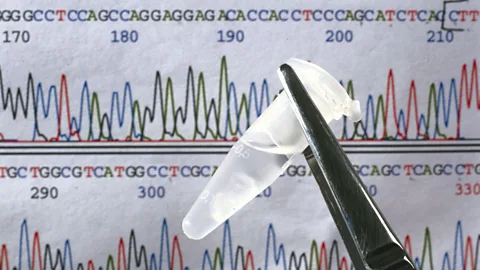 Getty Images
Getty ImagesMutations in these regions of so-called “junk” DNA are increasingly linked to a range of diseases, from Crohn’s disease to cancer.
Since Human Genome Project was declared complete in 2003, scientists sought to identify new regions among the three billion letters in our genetic code that could play a critical role in disease.
Thanks to technologies that can analyze whole genome samples more quickly and cheaply than ever before, a large number of genome-wide association studies – known as GWAS – have been published, identifying genetic variants linked to different chronic diseases.
For many geneticists, this task has proven to be the simplest, frustratingly so. The hardest part is understanding why these genes are relevant. For example, while GWAS have identified DNA segments associated with inflammatory bowel disease in 215 different chromosomal sitesScientists have only been able to identify the exact mechanisms involved for four of them.
One of the biggest challenges is that many of these DNA fragments are found in so-called genetic deserts, swaths of the genome that initially appeared to contain nothing of interest – genetic “junk” that could be ignored. After all, less than 2% of the human genome is dedicated to coding for genes that produce proteins, while much of the remaining 98% has no obvious meaning or purpose.
“You would say, ‘Oh, here’s a really important association and it increases your risk of many different diseases,'” says James Lee, a clinician-scientist who leads a research group at the Francis Crick Institute in London. “But when you actually look at this piece of DNA, there’s just nothing.”
 Getty Images
Getty ImagesFor many years, genetic deserts have been one of the most puzzling areas of medical science, but scientists are gradually accumulating information about their apparent purpose and why they exist.
Recently, Lee and his colleagues at the Crick Institute published a new investigation in a particular genetic desert called chr21q22. Geneticists have known about this genetic desert for more than a decade because it is associated with at least five different inflammatory diseases, including inflammatory bowel disease (MII) to a form of spinal arthritis known as ankylosing spondylitis. Yet, it has always proven difficult to decipher its function.
However, for the first time, Crick scientists were able to show that chr21q22 contains an activator, a segment of DNA capable of regulating nearby or distant genes, capable of increasing the amount of proteins they produce. Lee refers to this behavior as “volume dial.” Digging deeper, they discovered that this activator is only active in white blood cells called macrophages, where it can speed up the activity of a previously little-known gene called ETS2.
While macrophages play a vital role in removing dead cells or fighting harmful microorganisms, when the body produces too many, they can wreak havoc in inflammatory or autoimmune diseases, flooding the tissues. affected and secreting harmful chemicals that attack them. The new study demonstrated that when ETS2 is stimulated in macrophages, it increases virtually all of their inflammatory functions.
Lee describes it as “the central orchestrator of inflammation.” “We’ve known for some time that there must be something at the top of the pyramid telling the macrophages to behave this way,” he says. “But we never knew what it was. The exciting thing is, if we can target it somehow, we might have a new way to treat these diseases.”
 Getty Images
Getty ImagesBut if genetic deserts are capable of causing us so much harm, why are they in our DNA?
Looking back in time, Lee’s colleagues at Crick’s Ancient Genomics Laboratory were able to show that the disease-causing mutation in the chr21q22 gene first entered the human genome between 500,000 and a million years ago. This particular DNA change is so ancient that it was even present in the genomes of Neanderthals as well as some ancestors of A wise man.
It turns out that its original purpose was to help the body fight off foreign pathogens. After all, before the invention of antibiotics, the ability to rapidly trigger an increased inflammatory response through ETS2 was extremely useful. “In the first two hours after the bacteria are detected, it speeds up the macrophage response,” says Lee.
As a result, completely blocking ETS2 could leave IBD patients vulnerable to future infections. However, according to Lee, when its activity is decreased by 25 to 50 percent, it appears to be able to cause a profound anti-inflammatory effect, without the risk of making the patient too immunocompromised. Although this theory has not yet been tested in clinical trials, researchers showed that MEK inhibitors – a class of anticancer drugs capable of dampening ETS2 signaling – were able to reduce non-inflammatory inflammation. only in macrophages but also in intestinal samples taken from people with IBD.
This appears to represent a new path to an entirely new class of treatments for IBD patients. “Some of these MEK inhibitor drugs have side effects, and what we’re trying to do now is make them more targeted and safer, so that for chronic diseases like IBD, we can actually offer patients a drug that can stop the inflammatory process and help them feel much better,” says Lee.
The Crick researchers are now turning to the four other diseases that have been linked to the chr21q22 gene desert, to see if altering ETS2 activity can also help alleviate the excess inflammation that appears to drive this disease.
“One of the most serious illnesses is an inflammatory liver disease called primary sclerosing cholangitis,” says Lee. “It is a particularly dangerous disease because it can cause liver failure requiring a transplant. It can also lead to a much higher risk of liver cancer, and this can occur in young people. And at present, no drug has been proven to be effective, there is very little to offer patients,” he says.
From cancer to lupus
Scientists also predict that studying genetic deserts will provide vital information that will help improve our understanding of the different pathways involved in tumor development.
For example, cancer researchers having identified a genetic desert called 8q24.21 that is known to contribute to cervical cancer because the human papillomavirus, the leading cause of the disease, embeds itself in this part of the genome. In doing so, the virus enhances a gene called Myc, a well-known driver of cancer. Studies suggest that the link between 8q24.21 and Myc may also play a role in a number of ovarian, breast, prostate and colorectal cancers.
Richard Houlston, of the Institute of Cancer Research in London, says that various genetic variants identified as contributing to the hereditary risk of many common cancers have been discovered in genetic deserts. Knowledge of these target genes will provide opportunities for drug discovery as well as cancer prevention.
However, Houlston points out that translating this knowledge into new therapies for cancer is more difficult than for IBD because tumors are not static targets, but continually evolve over time. “That’s the challenge, whereas with Crohn’s and other bowel diseases, it doesn’t evolve,” he says.
 Getty Images
Getty ImagesLee is optimistic that the Crick’s work on IBD will provide a model for how researchers can find new ways to understand the pathways involved in all kinds of autoimmune and inflammatory diseases. Scientists at the institute are currently studying other genetic deserts that have been linked to diseases such as lupus, a disease in which the immune system damages the body’s tissues, leading to symptoms such as skin rashes and fatigue.
Other research centers around the world, such as the University of Basel in Switzerland, are also investigating how single inherited mutations in gene deserts could lead to certain rare genetic diseases. Three years ago, scientists in Basel discovered how one of these mutations could lead to the birth of babies with limb malformations due to its regulatory effects on a neighboring gene.
Lee predicts that understanding the role of genetic deserts will ultimately help improve the notoriously inefficient drug development process. “Creating new drugs for these diseases is a catastrophic failure,” he says. “Only about 10% of drugs entering clinical studies are approved at the end, so 90% of them fail because they don’t make people better. But if you know that your drug in development targets in makes a sustained path According to genetics, the chances of this drug actually being approved are at least three to five times higher.
